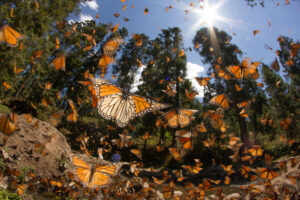There are about a dozen different grasses, and most lawns will contain a mixture of them. In some cases your lawns may not have grass at all, but instead a combination of weeds and other things. Most lawns fall into one of these two types: warm and cold season grass.
Warm season grasses are those that thrive in warm-weather regions, such as the Southern United States.
Cool season grasses are those that do best with extreme temperature fluctuations, such as those found in the North, Northeast, and Pacific Northwest.

Cool Season Grass Types
Turf Type “Fine” Fescue
The name “fine’ fescue is a term for the various species of grasses in this collective group: red, chewings, hard, and sheep. These are very fine textured with needle-like blades. Fine fescues are popular types of grass due to their shade tolerance. However, they do not tolerate heat and dry conditions well.
Kentucky Blue Grass
Kentucky bluegrass is one of the most popular types in the Northern Climates. It has a deep, green color and considered to have excellent texture. It grows well from seed and is a very popular choice for sod farms in the North. It grows from a very extensive system of rhizomes, (these are underground stems) that produce new plants. It does not grow well in deep shaded areas.
Rye Grass
Rye Grass is easy to spot in your lawn due to its shine. Also, it leaves a “whitish” cast when it is mowed. It is a bunchgrass; this means it germinates quickly and is often found in seed mixtures with Kentucky bluegrass. It is primarily found in cool-season areas of the North, but keep in mind in may not survive as far north as Minnesota, Wisconsin, or Canada.
Tall Fescue
Tall Fescue Grass can be found in hotter regions due to its ability to tolerate heat. It is a bunchgrass that is often used in athletic fields because it can withstand heavy use and foot traffic. In some lawns, patches of tall fescue may stick out and appear as a grassy weed. It grows in bunches and is not used very often in seed mixes.
Warm Season Grass Types
Bermuda
Bermuda grass makes for a nice home lawn because it can tolerate a very low mowing height, it is commonly used on golf courses in the South. It spreads by both stolons (above ground) and rhizomes (below ground), because of this it tends to form a thick, dense turf. It is usually found in the South but may grow in the southern areas of the North. Its maintenance requirements (fertilizing, watering, mowing) are high.
Bahigrass
Bahigrass is mainly found in California and Arizona, it forms a dense turf. The leaves spread opposite of each other along creeping stems. It does require a constant supply of fertilizer and is often attacked by common law weeds.
Centipede
Centipede grass is best for warm-arid regions such as Florida and the Gulf Coast region. Occasionally, it can be found in areas of California. It is not at all tolerant of cold temperatures and requires a lot of moisture for survival. It is a very coarse-textured type that grows above-ground (stolons) and they can reach several feet. It has very broad blades compared to other types of grass, with a rounded tip.
Zyosia
Zoysia is found mostly in and from the middle part of the U.S. and east toward the Carolinas, it forms a lawn that feels like a thick, prickly carpet. It can be found in the North but will turn brown once the weather turns colder. It is very slow growing, so it can take more than a year to establish a lawn of zoysia grass. It has stiff leaf blades and will produce numerous seed heads if it isn’t mowed regularly.




